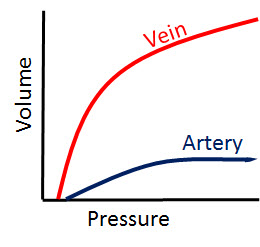Vascular Compliance
Tags | |
UUID | 733203b7-dacc-11e3-b7aa-bc764e2038f2 |
Vascular Compliance (C) is the ability of a blood vessel wall to expand and contract passively with changes in pressure. This is an important characteristic of blood vessels representing the relationship between volume of the blood vessel and the blood vessel's trans-mural pressure. A greater compliance allows a blood vessel to expand with less pressure required, enabling the blood vessels to more readily accept changes of blood pressure.
Where:
- V = Volume
- P = Pressure

Vascular Compliance is the relationship between the volume of blood within a vascular segment and the blood pressure exerted on the walls of that vascular segment. The graphic depicts notionally the difference in vascular compliance between veins and arteries.
The artery typically has a lower compliance at lower pressures and thus the relative pressure increases substantially with a relative small gain in volume in an artery at lower pressure. Comparatively, the volume in a vein increases more rapidly with pressure (in the lower pressure range) because the compliance in general is higher. Notice also that the curves for both the vein and the artery level out to a similar slope (similar compliance) at higher blood pressures.
- Comments
- Attachments
- Stats
No comments |
